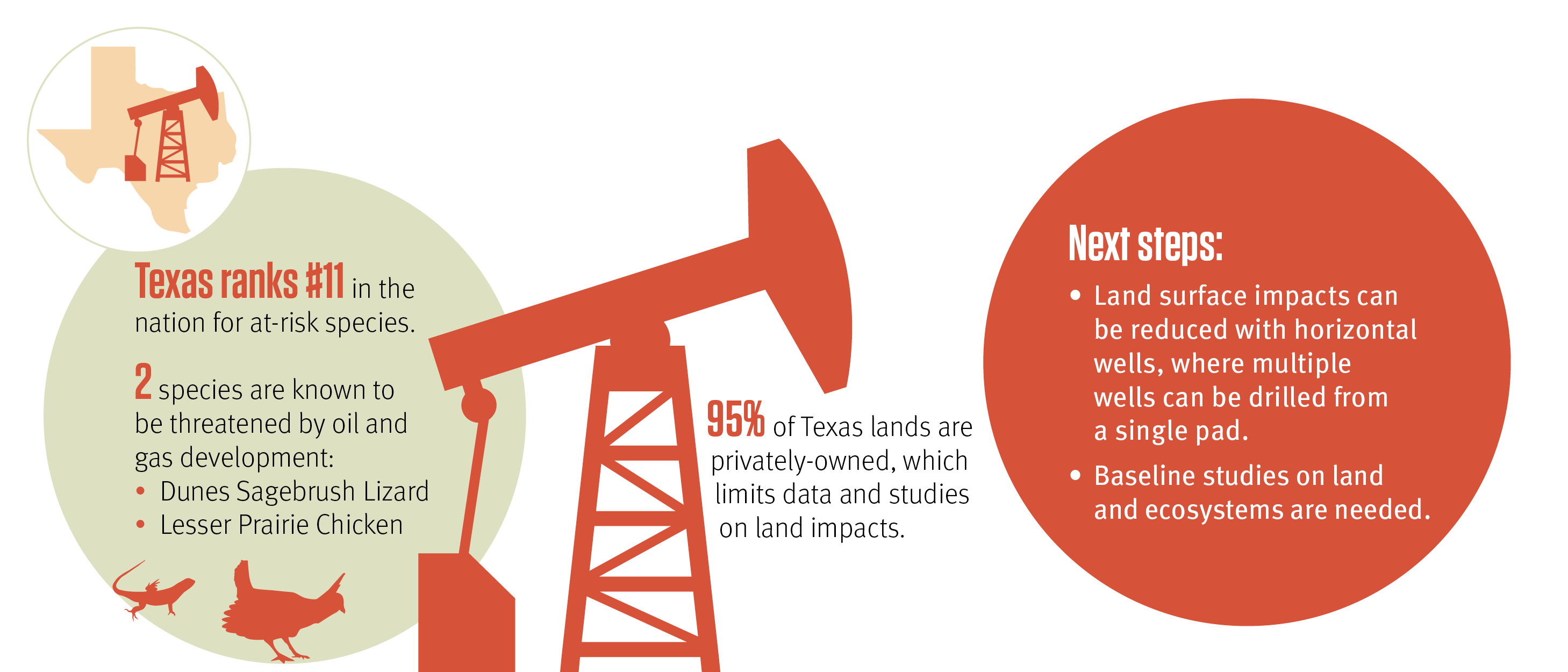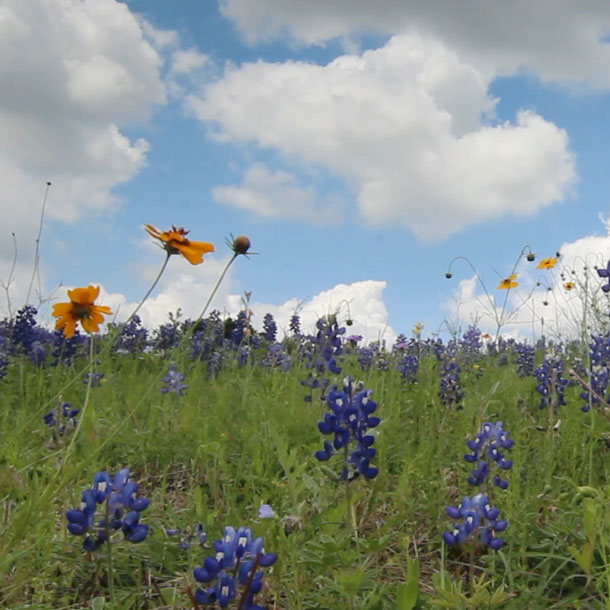Land Impacts

- Texas ranks #11 in the nation for at-risk species.
- 2 species are known to be threatened by oil and gas development: Dunes Sagebrush Lizard and Lesser Prairie Chicken.
- 95% of Texas lands are privately-owned, which limits data and studies on land impacts.
- Land surface impacts can be reduced with horizontal wells, where multiple wells can be drilled from a single pad.
- Baseline studies on land and ecosystems are needed.
- Texas is the only major oil and gas producing state without a surface damage act to protect landowners. The state should study the advisability of adopting a surface damage act.
Frequently Asked Questions
Shale oil and gas development activities in Texas have resulted in fragmentation of habitat on the landscape. However, there is a lack of information and scientific data on what the impacts of fragmentation have been and are on landscape—vegetative resources, agriculture and wildlife. Two species are known to be threatened by oil and gas development: the Dunes Sagebrush Lizard and the Lesser Prairie Chicken.
There is not a good baseline for land impact information since much of the land in Texas—95%—is privately-owned. Research of potential impacts on land and ecosystem resources has been limited due to access constraints associated with private land ownership. Without this baseline, it is challenging to understand the impacts of fragmentation.
What can be done to minimize the land impacts of oil and gas development?
There is an opportunity to minimize the impact on land from oil and gas production by using a single pad for multiple wells. This reduces the overall impact on the landscape as many horizontal wells can be drilled from this single pad. Sometimes it makes economic sense for operators to use this approach, but it doesn’t always. Hopefully by highlighting the fragmentation impacts, operators will be encouraged to do this more in future shale developments.
What impact does oil and gas development have on landowners?
Texas is the only major oil and gas producing state that does not have a surface damages act in place to protect the owners of surface rights when mineral owners come and drill on their property. It is recommended in this report that the state study this issue and decide if it should go the route of other oil and gas producing states and adopt a surface damages act.

“We know that there’s a lot of fragmentation of habitat on the landscape. But there are really very few, almost no studies of the impact of the fragmentation on the wildlife. There’s a real gap in knowledge that needs to be addressed with studies.”
~Melinda Taylor, The University of Texas School of Law
Land Findings
- Texas hosts an extraordinary degree of biodiversity, due to the diverse topographic, geologic and climatic conditions across the state.
- Texas lands are almost entirely privately-owned. Shale development takes place largely on private lands, which generally are not sites of formal environmental impact studies.
- The few studies that have been conducted on erosion and soil contamination from oil and gas development in Texas indicate that well pad development has an increased potential for erosion, and that soil contamination is possible from oil and gas production.
- The vast number of new wells drilled in shale formations in Texas since 2007 have had substantial spatial impacts on the landscape. However, horizontal wells have a smaller impact than the equivalent number of vertical wells would have had. When operators use a single well pad for multiple wells, surface impacts are significantly reduced.
- The most comprehensive information on species-specific impacts has been compiled for the Dunes Sagebrush Lizard and Lesser Prairie Chicken, with extensive studies of changes to their habitats and their life cycles and requirements. Both species are covered by voluntary conservation plans overseen by state agencies.
- Landowners in Texas who do not own the mineral rights associated with their property have very limited control over oil and gas operations.
- Most states where development of shale resources is occurring have a surface damage act in place to protect the rights of landowners who do not own the mineral rights associated with their property. In Texas, if the surface owner controls any portion of the mineral rights, the owner may be able to use contractual provisions to negotiate with the operator and resolve disputes. In addition, if the owner discovers damages caused by the operator within the statute of limitations time frame—two years—the tort/legal system may provide relief. Damages for the landowner are capped at the value of the damaged property and do not cover the actual cost of remediation.
- Data on environmental impacts of oil and gas development reside in several different state and federal agencies, and there is not a single database, readily searchable and available online, that integrates the data across different entities.
Land Recommendations
- Baseline land and habitat conditions at the oil and gas play level should be characterized, and changes to wildlife populations and vegetation should be tracked over time where there are opportunities on both private and public lands.
- The effectiveness of voluntary programs to conserve at-risk species should be studied, along with options for incentives to conserve at-risk species and reduce effects on land resources by oil and gas development activities.
- Advantages and disadvantages of adopting a surface damages act to address the gaps in legal protection for landowners who do not own the minerals associated with their property should be evaluated.
- The existing, nonproprietary information about land impacts of shale development that is collected and evaluated by multiple state and federal agencies should be assembled and made available online to the public.

Melinda Taylor (Lead)
The University Texas School of Law

Joseph Fitzsimons
Uhl, Fitzsimons, Jewett & Burton, PLLC

Tracy Hester
University of Houston Law Center

